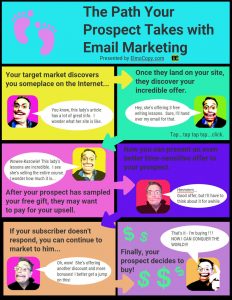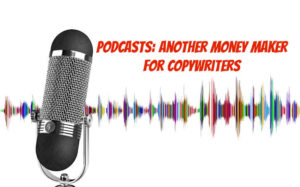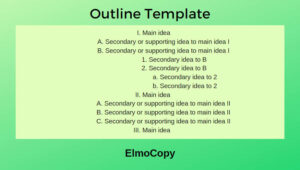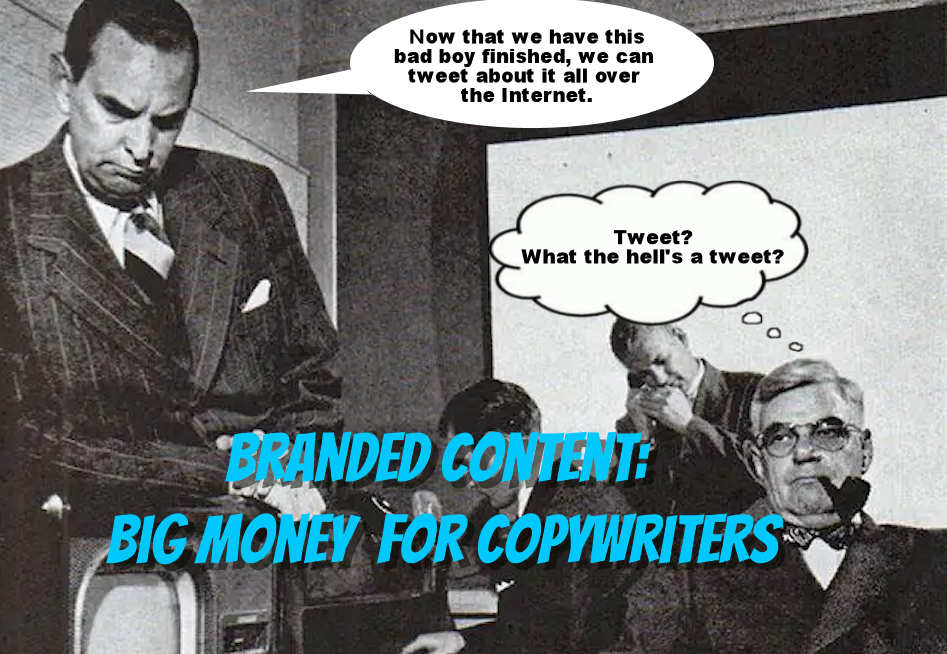Do you want to know how to make even more money in the copywriting business?
Thanks to the power of the Internet, every business can promote its products and services across the planet.
But this is like a good news / bad news joke.
Not only has the Internet increased opportunities, but it has also increased competition.
For this reason, businesses have to come up with all kinds of ways to build their brand, and the best way to do that is by creating brand awareness.
This has created a massive boom for copywriters to make money.
In this post, I will introduce you to 5 ways you can make money by creating branded content. So if you want to cash in on this massive copywriting opportunity, keep reading because it will probably get bigger.
What is Branded Content?
What is Branded Content?
Branded content is simply content created by a company to promote its services or products.
This can be done by creating content that:
- Builds brand awareness
- Delivers value to readers
- Engages and retains customers
- Drives traffic and increases conversions
In a minute, I’m going to give you a list of a lot of different kinds of branded content copywriters can create for companies, but first consider these facts:
81% of consumers need to trust a brand before they consider buying.
Do you find yourself buying the same brands over and over again? One of my favorite products is from a company called Darn Tough Socks, and they are so durable that if they start coming apart from wear, the company will replace them. I have tried to wear the dang things out, and it’s impossible, so I’m a fan.
77% of consumers prefer shopping with brands they follow on social media.
Exclusive previews, introductory offers, and contests are great ways to get exposure on social media. Creating these assets requires copywriters who can write them for clients eager to promote their businesses.
There are over 10,000 branding & positioning agencies and over 150,000 independent marketing contractors worldwide.
The need to create branded content is so vast that all the agencies and contractors can’t keep up with the demand, and you don’t have to be a brilliant writer to get started.
One of the first businesses I worked for needed branded content, and I started writing promotional emails for them and ended up writing their eBooks, manuals, and website copy.
The good news for you is that if I did it, so can you.
Listed below are the different kinds of branded content you can write for clients.
#1 Video Promo Scripts
Rates: $150 – $1000
The most dynamic way to promote a business is by creating videos.
However, showcasing products and services is not as easy as you think. Presenting the benefits and features of what you are selling must be planned and executed just like a blog post or an email campaign, and that’s where a good copywriter comes in.
A copywriter specializing in scripting can help a business determine the purpose of creating them, such as increasing brand awareness, educating consumers, or promoting. But, the main focus of a video copywriter is writing the scripts.
Due to the technological intervention of the cellphone, producing branding videos has gotten easy, and just about anyone can make them.
However, if you don’t know how to plan and write a basic sales message, you will have crappy conversions and enter into the frustration zone.
Here is an example of what happens when you have a video not scripted by a copywriter:
Not only will a good video copywriter know how to present the benefits and features of a service or product, but they will be able to tell a story that captures an audience.
Sidenote about these videos: I find it rather humorous that the highly polished, cinematic video has a mere 1.6 million views, while the horrible mall promotional has 25 million.
Perhaps there is value in creating crappy videos.
Who knew?

#2 Infographics
Rates: $150 to $2000
Infographics are a popular way for companies to share branded content with their followers, and copywriters can make money writing and organizing the content in them.
Infographics translate complex information into easy-to-digest graphics.
Copywriters who know how to break down complex ideas into easy-to-understand images and short sentences will be valuable to companies that use this form of branding. If you are a copywriter who knows how to do the graphics yourself, you can make more money by charging for that service.
Here is a video where I show you how to use online programs to create infographics without paying for online graphic services:
The Basics of Creating an Infographic
Here are the basic steps to creating professional infographics:
What is the Message?
First, identify the message you want to send because it should fit within the company’s values and objectives. Try to schedule meetings with the company marketing leaders and probe for the type of message they think will help their business.
Gather the data
Ask the businesses you’re writing to give you as much data as possible about the subject. If the company has been in business for a long time, it should have all kinds of support material to draw from. Tell the company to provide you with any brochures, whitepapers, stats, and data they have accumulated over the years.
What if the Company Doesn’t Have this Stuff?
If they don’t have any data, you have two options: try to gather it yourself or decline to help them. I know the latter sounds harsh, but if they don’t have any data or resources on their business, you will have a hard time writing for them.
Create the Graphics
Once you have all the information pieces, it’s time to create the graphics. If you are not a graphic artist, you can use graphics generators like Canva or Venngage. Both companies display work by other infographic creators and ideas that you can use to create your own infographic.
I have used both the paid and free versions of these services, and I highly recommend them. For most infographic creators, this part is the most fun and rewarding.
Promote Your Infographic
Next, you will need to promote the infographic, so place it on as many social media channels as possible. The most effective way to promote an infographic is to contact influencers in your niche and ask them to share it. If you can put the company’s branding in the infographic, do it, but do not make it an over-the-top dominating force on the image.
Finally, track the success of the infographic and ask followers to comment on it to see if it was helpful in some way.
#3 Social Media Branded Content
$1000 – $2000 per month
As you already know, placing branded content on social media channels is massive. So far this year (2023), 4.7 billion people are using social media, and companies have spent $260 billion on ads.
Those companies need copywriters to help them write content to get their marketing messages out.
Establishing the Tone of Voice
A vital task for a copywriter is setting the tone of voice.
Your voice is what you need to say to your prospects or followers. If you promote a unique light bulb, you will talk about how your product helps people.
The tone is how you say it.
Will you use a casual style – like talking across a table and having a drink? Or will you use a more scientific one – as you would use in a whitepaper?
How I Got Schooled by a Client
Years ago, when I started writing for companies, I got a gig writing for a solar panel company’s website.
I wrote the material in a casual tone that was easy for the average person to understand. Wrong! The owner of the company told me to rewrite it all. He informed me that their target users are big companies who look at all kinds of scientific data.
Also, because solar energy in an average home is a significant expense, even homeowners want to see technical stuff too. So, I had to go back and rewrite the web copy in a highly scientific and technical tone.
Do you see why this is so important?
If you provide content for a company’s social media posts, you must use a tone that fits their marketing.
Teasing the Audience
While copywriting, you will always want to lead with a headline that catches attention and creates curiosity. It’s no different with social media. Your first line of text needs to grab readers by the eyeballs, so lead with your best shot.
Here are a few examples of social media lead lines that got a lot of attention:
Social Media Examiner: NEW: Social Media Marketing Strategy: How to Thrive in a Changing World
Hootsuite: Social media prediction: The 2020s will see an explosion of new platforms.
Delta Airlines: What destination is #1 on your travel bucket list?
Increasing Brand Awareness
Creating a social media campaign is similar to creating a content marketing or email campaign. If you only send out sales messages, your social media efforts will fall flat, so you should build a content schedule with a mixture of the following kinds of posts:
- Holidays
- Special events
- Customer testimonials
- New products
- Different products
- Links to relevant content
- Sales images of products with a lead
- Stories
You could also promote other marketing assets like blog posts, eBooks, and videos.
Responding to Customers
If you are working with a large company, hopefully, you will be working with a team. One of the writers should be able to respond to customers’ and clients’ responses, questions, or complaints.

#4 Podcasts
$500 to $1000 per minute
Believe it or not, there are several ways a copywriter can help create branded content for podcasts.
In case you don’t know what a podcast is, here is my definition:
A podcast is a type of audio program that you can listen to on the internet.
It is similar to a radio show, but instead of being broadcast over the airwaves, it’s available for download or streaming on the internet.
Podcasts can cover a wide range of topics, from news and politics to entertainment and education, and they can be produced by anyone with a microphone and a computer.
You can listen to podcasts on your computer, smartphone, or other mobile devices, and you can subscribe to your favorite podcasts to get new episodes delivered to you automatically.
How to Write a Script for a Podcast
If you want to write a script for a podcast, you need to plan on the front end.
This process doesn’t need to be drudgery – and you can have fun with it, but having a structure to your podcast is important.
Set the Topic
Decide on a specific topic for your podcast, and if your client is smart, they will have a content schedule already written out.
(I know a lot of good copywriters who won’t even sniff at a client that doesn’t have a content marketing plan.)
If you are going to help them generate ideas, here are some suggestions:
1. Use Google to search for the top posts on the subject you are writing about and read the top ten. Take notes on the best ideas you find in the search and sort them out to create a content plan.
2. Look at the best-selling books in the niche you are writing for on Amazon. Use the “Look Inside” application that Amazon has so you can look at the table of contents.
Doing this task makes it easy to get ideas from perusing this information.
Once again, take notes on ideas you think will work.
3. Plan a meeting with your client and brainstorm ideas, and tell your client to ask any team members to write down at least 10 different ideas a month.
4. Get a free subscription of Neil Patel’s Ubersuggest and learn how to use it.
Ubersuggest has a search function that will let you see which content is shared the most.
Type in your subject and take a screen capture of the results because you can only do two searches a day on the free version, but those searches can yield a lot of good information.
Research Your Idea
Once you have a specific topic to write about, you need to do more research.
I know what you’re thinking.
You are thinking, “Wow, look at all the research I had to do to set the topic, and now he wants me to do even MORE research?”
Yes, but once you are done generating all those mind-blowing topics, you can set them aside and focus on one specific topic.
How are you going to do all of that research?
By doing the same procedure, I showed you in the Set the Topic section above, perform a search of the top 10 posts, checking out the best sellers on Amazon.
Also, conduct brainstorming meetings and use Ubersuggest.
Remember, you are now researching one specific topic, not a bunch of them.
Create an Outline
Now it’s time for the rubber to hit the road, and you will now take all the ideas and make an outline for your script.
Here is how you can create an outline for your branded content podcast:

And so on…
You don’t have to fret about this process too much – just take your ideas and organize them.
Write the Script
Many of the podcasters I’ve worked with in the past take the outline and all the research material and read it.
While they record the podcast, they merely use the outline as talking points.
Why?
If they read a script for their podcasts, it sounds boring.
One of the reasons why listeners like podcasts is because they sound like a natural conversation. I used to listen to a lot of talk radio, and basically, that’s what a podcast can be – a talk show.
However, there will be times when a strict script will be needed for a podcast because the client or company wants the best-branded content.
Larger companies have more to gain or lose based on the kind of marketing they produce, so they want a polished script.
Remember how I talked about using a certain kind of tone of voice?
You’re going to need to do that when you write your script.
Look at the company’s branded content marketing materials to get an idea of how they want the tone and make notes of the language and what grade level the readers are at.
(Believe it or not, most people read at an eighth-grade level or below.)
If your client wants it humorous and lighthearted, try to write it that way, so add jokes and life stories to the script to make it real.
Revising and Editing Your Podcast
I like using Grammarly or the Hemmingway Application because they tell me when I’m writing complex sentences.
Unless you are scripting highly technical or academically advanced material, you should have a script that is easy for most people to understand.
Over the years, I’ve written for cryptocurrency companies, and that was highly technical and challenging. As a matter of fact, writing for crypto was almost like speaking a different language.
Have your client go through the script once you’ve finished it so you can make adjustments.
More Podcast Money Makers
Create Podcast Content Schedules
Any pro copywriter will tell you that a schedule is vital to a content marketing campaign.
Copywriters who can pitch podcast ideas to hosts and producers and create a subject list for them will be very valuable. This means that the copywriter will also be brainstorming ideas for the producer thus making their job easier.
One easy way to build a list of ideas for a prospective client is to use the free trial version of a tool like Milan Note. Milan Note specializes in creating lists for podcasters that makes the task quick and easy.
Writing Podcast Advertisements
Another way entrepreneurs can promote their products and make money is by selling products and services during their podcasts. A podcaster should have a clear picture of his target audience to write a sales promotion for their business.
Here are a few things to keep in mind while writing advertising copy for a podcast:
Start With a Persuasive Suggestion
Just like writing a sales letter or selling by email or a direct mail piece, you must use a compelling suggestion or hook to grab an audience’s attention.
Some easy ways to do this are by making a bold statement, asking a stunning question, or presenting surprising statistics.
Example: “The Average American Family watches over 85 hours of TV over the course of a week. If you are concerned about your mental health, stay tuned for vital information that could help you and your loved ones overcome this addictive and hazardous lifestyle.”
Focus on Benefits
Don’t worry about features too much. Instead, focus on how the service or product will help or make their lives better in some way.
If you promote video security equipment, don’t blather on about how it will look hanging on your porch. Instead, emphasize how much safer it will make your family.
The best way to do this is to brainstorm with the client about how the security equipment will make life better for a customer.
Social Proof is Important
Get as many testimonials in your podcast advertisements. Use voices of different people who love your product or services to promote what you are trying to sell.
In most commercials, you’ll hear actors who are extolling the virtues of a business or product, but the testimonials have to be real, or you will run the risk of being a scam artist.
Use Urgency and a Call to Action
There are many ways to create urgency in your podcast sales copy. You can tell listeners that there is only so much of your product left or that you are running a promotion that will end in a few days. (The latter one is the one I receive the most in email sales letters.)
Finally, give your listeners a call to action. You can combine it with scarcity to make it more effective:
“In 24 hours, this incredible offer of $24.99 is going away, so grab your copy today by clicking the link below right now.”
Consulting Services for Podcasters
Copywriters can offer consulting services to podcast entrepreneurs because branded content can be implemented in ways that help podcasters develop their unique voices. A professional copywriter can provide feedback on scripts, subjects, and marketing while offering writing services like content planning and marketing strategies.

#5 Email Marketing
$250 to $2000
Another way businesses can create branded content is by using email marketing. As a matter of fact, email marketing can be used in many different ways to promote a business.
In the section below, I’m going to tell you how to write a campaign for a client using simple steps.
Email Marketing Campaign – The Basics
I have written quite a bit about the virtues of email marketing lately because it is still the cheapest and most effective way to communicate with an audience.
If you are going to learn email marketing, you should go through the process of writing an entire campaign built around a product or a service.
Here are the steps on how to do this:
Step 1: Gather Your Resources
If you remember earlier when I told you to gather as much data about the company and its customers as you can on the front end of the project?
(I talked about it briefly in the infographics section.)
If you are going to write for a company or a business, and they don’t have any data about their own business and customers, I would drop them because it will be an uphill battle, and if your campaign falls flat because you have to do all this work for them, they will blame it all on you.
Been there, done that.
Here is what you should ask them for:
-
- Files of their prior email campaigns
- Avatar data on their customers or clients
- Advertisements they have been running
- Brochures they hand out
- Mission statement
- List of their salespeople you can interview
- Testimonials from clients
- List of satisfied customers you can interview
- Links to comments like Google reviews, Yelp, Amazon comments, etc.
- A list of their competitors
As I said, if they don’t have this stuff, run because you will beat your head against the wall trying to write for them.

Step #2: Sort Out This Information
Once you have gathered this information from your clients, you need to read and sort it out to understand what they need.
What are their interests, needs, and pain points?
What problems do their customers and clients need to be solved?
One easy way to get this information is to spy on your client’s competitors. Check out their websites, comments, testimonials, advertisements, and anything else you can find.
If your client’s competitors have been in business for a long time, there should be tons of information you can copy and paste into a file.
If they don’t have any local competitors, so what? You can use the Internet to find similar companies all across the country.
I once had some friends who were starting a car storage facility business but had no clue how to market themselves. So, I jumped online and looked up all of the companies that were car storage facilities in big cities and had longevity.
I got so much information about how they could market their business; it blew my friends away.
(I only do this type of thing for friends, if I do this much research for a client, I charge them separately.)
Set the Goals
You will need to meet with your client to help them set goals for their campaign.
Are they trying to send their audience to a website, video sales letter, or an affiliate sales site?
Do they need to increase their brand awareness or generate interest in their products and services?
Do What Artificial Intelligence Can’t
Lately, copywriters are using AI for all kinds of writing and have raised concerns over whether this will take their market share.
Let me ask you a question – can AI sit down with a client and help them set goals?
Can AI empathize with your clients and discuss their problems and dreams?
You can stand out from AI and competitors by giving them the personal touch.
Organize and perform brainstorming ideas with your clients. Give them ideas on how to interest their audience and deliver valuable information.

Big Tip: Another Way You Can Beat AI
Let’s face it business is a battlefield. Every day you have to innovate, motivate, adapt, and overcome.
A year ago, I had a repeat client with some problems. Her business and customers were driving her nuts, she was working hard, and her husband was very sick.
So, I sent her a handwritten card with inspirational thoughts and a few jokes to help cheer her up.
I got an email from her a week later telling me that the handwritten card was the kindest thing anyone had done for her in a long time and how much she appreciated it.
Listen, I had no motivation other than to help this person.
Can artificial intelligence care enough to extend random kindness to others?
I believe the days of merely performing the work or exchanging money for a product are over. Copywriters will fare much better if they can connect on a deeper, more personal level.
So, anytime you can meet on a Zoom meeting, send a handwritten card, call on the phone, or do anything more personal, do it.

Step # 3: Use Different Kinds of Content
So far, you have determined your goals and discussed what your clients want to achieve with an email campaign.
You have also created an avatar and studied your client’s marketing materials so that you know all the benefits, features, and desires of their customers and clientele.
The next step is creating a schedule for the email campaign, because an email schedule or calendar will help you see where you are making mistakes.
For example, you should avoid is send sales messages all the time.
That is a big mistake because you want to gain the trust of the people who are on the mailing list.
Here are some of the different kinds of emails you can send:
Direct Pitch
A direct pitch is one where you try to sell a service or a product in the email, and it is usually a lone email.
Here is an example of a direct pitch:
Subject line: Ooops, We Overprinted! Select Books Are Now at $10
GET OUR BEST BOOKS – AT A PRICE TOO GOOD TO PASS UP! Books previously priced at 17.99 are now $10. To get them now, click here: Shop Now
As you can see, it is a sales announcement, and they are used frequently in email marketing campaigns.
Tell a Story
Another kind of email you can use in a campaign is the story email message.
It doesn’t matter if it is a true story or a made-up one to make a relevant point.
I like to use real stories because they have more impact, but I have seen storytelling emails that were made up that were very effective.
Whatever style you use, ensure it is relevant and pushes your brand along. Your branded content should promote your business and not merely entertain email recipients.
Lessons, Tips, and Advice
This is a common way to promote a business by giving out valuable information that readers can use.
Here is an example of a helpful email:
Subject Line: Setting Yourself Apart from Your Competitors
How do you set yourself apart from a whole bunch of competitors?
I start by looking at those 5 emotional factors: Love, Pride, Fear, Guilt, and Greed. In the infomercial industry, I use fear a lot. I say,
“You know, there are lots and lots of people who can produce beautiful videos, they’ve come over from the entertainment industry, movies, regular video production, and ad agencies, but can they sell anything? Most do not know enough about direct sales and direct response advertising to fill a thimble. So if you’re not careful, you’ll wind up with an award-winning documentary. And here’s my advice: no matter who you use, or what production team you assemble, please make sure somebody in charge knows the fundamentals of making a sale by direct response.”
Now, by saying all that, I haven’t slammed any particular competitor and I haven’t boastfully sold myself, but I planted a great big fat seed of doubt. I’ve played on fear, and I happen to have given good advice…
Note: This is a very long email, so I had to cut it short, but I’m sure you get the idea.
Continuing a Past Conversation
This is an email that is built off of a previous one.
I usually say something like:
Hey Joe,
Do you remember a week ago when I told you all about the 7 principles of influence in your marketing?
Well, I have gotten a lot of feedback on that email, and many of my subscribers want to learn more. (I hope that you’re one of them. Hah-ha!)
So, in this email, I wilk expand on this subject and tell you how you can directly apply this to your business…
As you can see, I can string this conversation from one email message to the next.
It does not matter how many email messages I link together – but three to five can work for you and be sent a week apart.
Focus on One Aspect Emails
Creating a series of emails about a subject is an excellent way to keep your readers engaged.
For example, ff you are selling a toothbrush, in one email, you could talk about how plaque builds up behind the lower teeth and using this particular toothbrush helps eliminate all that plaque.
After that, you could explain how the toothbrush gets in between teeth better than other brushes.
See how that works?
Most products and services have a lot of aspects related to them, so you could write subjects endlessly.
Daily, I receive email messages about cryptocurrency telling me to invest.
Of course, these messages talk about all the dangers the government is creating with bad monetary policies and things happening in the world of finance.
As you can see, you could write about that stuff endlessly because the government is constantly doing weird things.
News Worthy Emails
These kinds of emails are easy to write because it is easy to keep people informed about what is happening in your industry.
Not only can you talk about what is happening in your industry, but you can talk about things happening in your company too. Try to write about subjects of interest related to your business, because all you messages should support your conversion rates.
Divided Branded Content
Instead of writing a long email, write tips about the business you are writing for. This is similar to writing a list blog post, but instead of sending the whole post, you could write about one tip at a time.
Step #4: Build Your Content Calendar
Now you can assemble a calendar for your content, which should be an easy task since I just gave you a list of all the different kinds of content you could create.
Here is a good tip for you: remember holidays.
There are all kinds of holidays you can mention in your emails. I’m not only referring to Christmas, Easter, Halloween, Independence Day, and Valentines Day.
There are all kinds of holidays you can write about as they occur.
October is a month that has a lot of them:
• October 1 – Clergy Appreciation Month
• October 8 – Clergy Appreciation Day
• October 9 – Indigenous People’s Day
• October 10 – World Mental Health Day
• October 11 -National Coming Out Day
• October 16 – National Boss Day
• October 21 – Sweetest Day
• October 24- United Nations Day
• October 31 – Halloween
Hallmark Cards has an entire list of the main holidays on its website.
So, creating a content calendar for your business is easy, and if you get creative, you can make a whole list of things to write about.
If you are writing for a company creating branded content, you need to put it down in a calendar so you will know what you will be writing about from one day to the next.
It will make it so much easier to create an effective email campaign that way.
Step #5: Test and Evaluate Your Email Results
Almost every professional email platform on the market has tracking software that will give you open rates and what links were clicked on in your email messages.
Email marketing experts have determined that a 15% to 17% open rate is desirable.
However, it all depends on the industry you are working in.
If you are writing for a building supply store that has been in business since time began, you will have a much higher open rate than a small business that performs accounting services.
If you are wondering what open rates are standard for the business you are working with, you will need to consult websites that collect data on that industry if it exists.
Newsletters
Depending on the size of your business, a newsletter can be used as a relationship-building tool by telling followers about events, guest appearances, new products, and other business-related activities.
One thing to remember is that an email newsletter is an effective way to stay connected with your customers or clients. People like to buy from businesses they are familiar with and like, so a newsletter can help build that relationship.
Merchandise Promotion
Companies can also use branded email advertisements to promote merchandise.
One way to get double value from a branded email promotion is to sell branded products. It’s not uncommon for corporations to put their logos on hats, shirts, and other items. Years ago, I got an email from the Tabasco hot sauce company. I’ve been a big fan of the product and was happy to learn that you can get Tabasco hats, shirts, and even branded underwear from them.
Surveys
Branded surveys are an easy and inexpensive way to get feedback from people who use your products and services. Many email services like Constant Contact or Mail Chimp have tools you can use to build surveys and send them out.
Here is a list of tips for creating a successful survey to get information from your email list:
- Use full-screen mobile-friendly forms
- Turn the survey into a poll
- Ask open-ended questions
- Use personalization
- Keep the questions simple and easy to answer
- Turn the survey into a gradable game
Getting people to respond to a survey is not easy because your readers may be too busy to take the time to fill it out. So, you need to be creative and test different ways to get them to participate.
If you aren’t getting a lot of responses from your surveys, it could be any number of reasons for what time they are receiving emails from you to not checking their email messages enough.
Conclusion
I hope I have given you enough ideas to help you make more money with your copywriting business.
But here’s a challenge for you.
Grab one of these branded content ideas and run with it. Once you have decided which one you’d like to explore, do an online search of the best resources about the subject.
Get the ten best posts you can find and read them.
Next, search for any free courses you can find about your choice. HubSpot has excellent free courses on many marketing subjects, and that would be a place to start.
If you have a little money to spend, take a cheap Udemy course. I recently took one about email marketing, and it was excellent.
You can also use Amazon’s search engine for the best books written on your chosen path. (Yeah, that’s right, Amazon is a search engine.) You don’t have to pay the top price for them, because you can get used ones cheap.
Once you do all this, you can start pitching clients using my method. You will need this password to access the video: elmondo (All letters are lowercase.)
If this post has helped you, I’d appreciate it if you would comment below.
That would make my day.


Dang, Elmo!
Can’t bealive how much value you packed in this article.
Hope it gets the love it deserves.
Keep the top-notch content flowing, man.
Loooking forward to your future publications.
Richard,
Thank you so much my friend for your kind words. I’ll try to keep the fires burning!